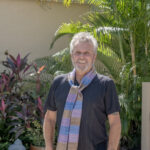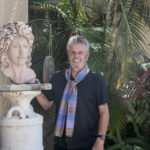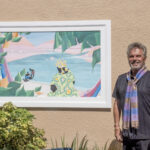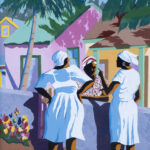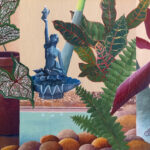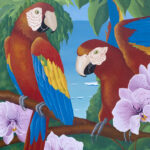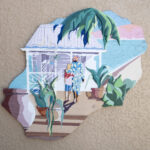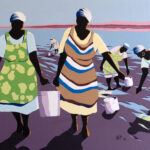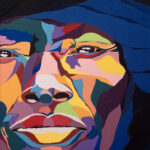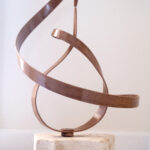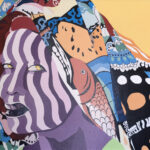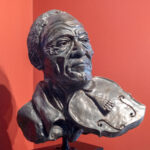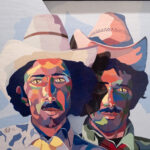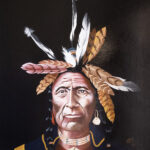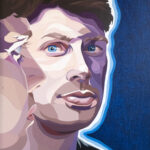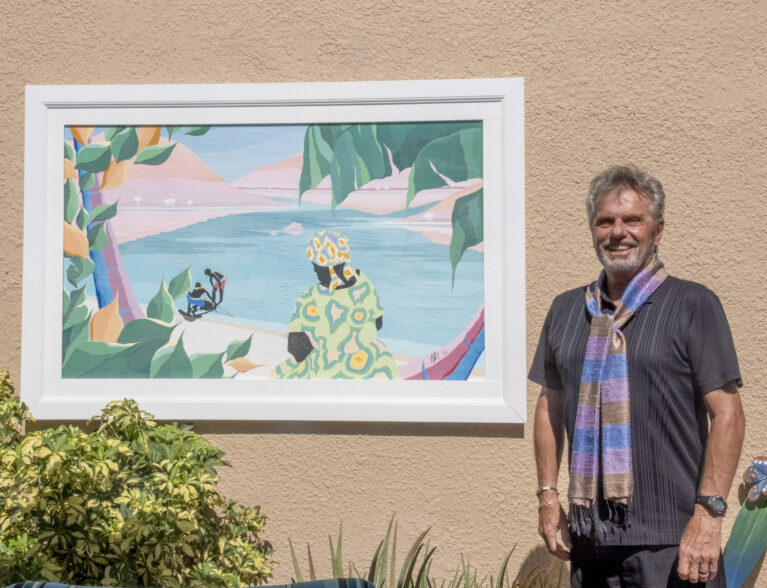
Intellectual curiosity has taken artist Ed “Eduardo” Uttridge down many paths during his lifetime.
Mathematics framed the early years of this retired nuclear physicist, and a series of entrepreneurial positions ensued, including ownership of a maritime financial consulting firm, a construction company, furniture making, real estate and even a magic shop in Sears stores.
“None of them were things that I pursued for a very long time,” says Uttridge, adding that the one constant has been “a freedom of learning.” And, while his academic training may have been analytical and ridged, his artistic adventure has not been.
“It’s not absolute. It’s not rigid, it’s not perfect. It allows me to be a lot freer than my academic training was involved with.”
Uttridge says his artwork began with watercolors when, joined by his daughter Darlene Davis, he began taking art classes at the Torpedo Factory in Alexandria, Virginia. It would set into motion a father-daughter collaboration that remains to this day.
For 10 years, he served as director of the Summit Art Group, where he counseled that even students who thought they had no artistic abilities could use art to discover a finer perception of the world around them.
After moving to Vero Beach with wife Jill, he began seriously focusing on his varied artwork, from large-scale paintings to the wooden kinetic sculptures and spiral woodblock sculptures he and Davis work on together. Their business, Patera Kori Studios, is a nod to their Greek lineage, the words meaning “father daughter.”
Despite living in different states, they are in constant communication, conversing via FaceTime numerous times daily about their sculptures. The kinetic works feature softly curved wooden strips, perfectly balanced atop a small stainless-steel ball bearing, that spiral in gentle spins with the movement of the air.
Uttridge explains that from the beginning of time, people have independently incorporated spirals into their works, attempting to replicate the precision found in nature, from pinecones to nautilus shells.
“The relationship between what you see in that spiral shows balance and harmony, and is aesthetically pleasing to the human eye,” says Uttridge, adding that even our life paths are spiral, rather than straight lines.
“You continually come back to things you thought you understood, and see deeper truths. The spiral is a symbol of growth and development. A progression in our lives isn’t always positive, welcoming, but you don’t have to be stuck at that place, you can move on,” he says, noting that as life is a progression, there are always new beginnings.
“In our lives, balance is very, very important. If we weren’t balanced, we would have a wobble,” says Uttridge, likening it to finding a center axis for their kinetic pieces.
The process of working, shaping and balancing each sculpture takes months, requiring them to slow down and be patient. Likewise, the slow, mesmerizing revolutions inspire the viewer to reflect and relax.
“We have so many frantic things going on in our lives. Joining balance and speed is the working with wood, slowly manipulating it. If we try and go too fast or too abruptly, it will splinter and break,” says Uttridge.
“We have to do this silently. The viewer just has to feel this calming and meditative, to be more balanced in our hectic lives.”
The father-daughter duo also incorporates spiral designs in functional art, such as sculptural woodblock pedestals for tables finished in their signature black and white color pattern.
Referencing a remark by David Foster Wallace in his “This is Water” speech on the “arrogance of certainty,” Uttridge says, “We as individuals have a perception of truth, what we feel is right.”
As the pieces in those sculptures move independently, turning them this way and that, he explains, changes our perspective.
“It reminds me of social commentary. It is our attempt to make a statement on where we are as a society. It is something I feel very strongly about, and it shows up every day in our daily lives,” says Uttridge.
He comments that whether it be conflicts in politics, religion or society, each of us has a perception of truth, of what we feel is right.
“We all have this arrogance of certainty. When you look at this sculpture you are seeing black and white. Unless you were willing to see things slightly different, you would have that same perspective. But all of a sudden, by turning one of the parts a different way, it’s a reminder that something has to externally change. Or if you as an individual move and change your perspective of things, either externally or internally, you have to move,” says Uttridge.
“So how do you change someone’s mind who thinks they are absolutely right? In my small way, individually, I am reminded to be open for a change in perspective; I look at something differently, based on my exposure to the world, to people.”
Painting figurative characters and faces, another of his artistic interests, is a solo activity, without Davis, and is based in part on a Swahili greeting he learned in Kenya in the mid-1960s while traveling on a merchant ship.
While the word sawubona literally means “I see you,” it traditionally recognizes the whole person.
“When I see a face, I am reminded of this Swahili greeting. Until you can see someone as a person, you’re not really engaging or knowing them as a person,” says Uttridge.
Although each of his faces is a fictional figment of his creative mind, and conveys a unique personality, each also comes with a story that is engaging, detailed and enchanting.
“Because I want to know something about that person, I then tell you, the observer, a story I write. As an artist, when we finish the painting and leave, the artist is silent. When that piece of art goes out into the world, the story communicates something that I was intending.”
Big and bold, he uses a high-grade acrylic house paint applied to plywood, which he says protects better than standard sealing coating against UV light and moisture. Many of them grace the open-air walls of their home’s courtyard and outdoor dining room, giving the space the feel of a gallery filled with color, pattern and depth.
Photos by Joshua Kodis
- Ed Uttridge
- Ed Uttridge

